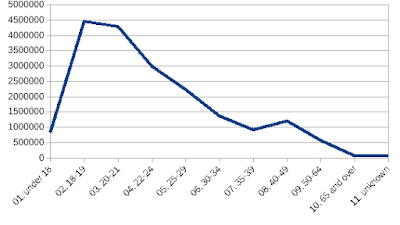As described in my previous articles, I have been working on importing all IPEDS (Integrated Postsecondary Education Data System) data into my database. After spending years on this project, I was able to import about 15 years' worth of IPEDS into the database with verification. There are still few files that, without major efforts, would be hard to handle properly - these are basically long lines with embedded new line characters in the line.
That being said, I was eager to run a test case with these IPEDS data. As the fate has presented itself, my previous articles were about adult college enrollment, and it happens that the college enrollment can be approximated from the IPEDS enrollment data.
For this article, the IPEDS fall (semester) enrollment data were first examined via my R interface code, which allows searching and checking definitions across data years. In this particular case, the R code reveals that, at 2009, the 'first professional' enrollment level disappeared from the level definition. By examining the IPEDS documentation, it is verified that from 2009 and on, the first professional enrollment is to be reported in the graduate enrollment level. Since I am a kind of familiar with the IPEDS data collection, I knew the enrollment age data were not mandatory for even-number years. If not, a quick R code that checking the total for each year should have revealed that.
Since in IPEDS, data were only tagged with college id (unitid), extra steps were needed to tag the data with attributes from the college. These attributes are made available through the so called 'Institutional Chararcteristic' survey. Whit this survey, colleges can be tagged with control (Public/Private), level (4 or 2 year college), location (state/address...). For this project, it was found that, in 2011, there were 3 institutions did not reported appropriate information for the 'institutional characteristic' survey. Luckily, two of them were available from other years. To preserve most data, we fixed the two with info from other year and coded the third one with special code so that we can include them if we so desire. For this article, we include all institutions that were collected by IPEDS and this include institutions that located on US territories and miscellaneous islands. To list a few, this includes AS (America Samoa), GU (Guam), PR (Puerto Rico), MH (Marshall Island) ... etc.
With previous adult college enrollment article in mind, under-graduate enrollment from the IPEDS was considered a better approximation to those from the ACS data.
Examining the IPEDS age data, it is noticed that not all data were collected with equal age span. For example, data are collected with age categories like 18 to 19, 22 to 24, 25 to 29 ... etc. Presenting age data directly with with these age categories results in the following chart and the chart can trick reader to think that there is a bump in the age distribution which sure not look like the age distribution presented in my previous article.
 |
| Age distribution using IPEDS age categories |
A better approach to resolve this would be using the average head count for each age category instead. Better yet, you can assign the average to each age in the category to provide a better representation in terms of age axis.
In this article, an average assigned to the category is used. To approaching the college enrollment data in my previous ACS based article, we presented the age distribution with the total enrollment, the sum of both full-time and part-time students. As shown in the following graph, it can be seen that the curve exhibits a familiar monotonic decreases after the primary peak around college graduation.
 |
| Age distribution for total fall enrollment using average for each age category |
Since the IPEDS data also allow the separation of data with full-time, and part-time, it is worth the efforts to examine these characters too. The overall (sum over states) full-time distribution can be seen in the chart below.
 |
| Age distribution for full-time fall college enrollment using average for each age category |
A typical age distribution for a state (NE) can be seen below. For most state, the only difference is whether the age group 18 to 19 or the age group 20 to 22 is the highest. The full-time fall enrollment age distribution for Utah, however, show a very different distribution - see chart below. This may related to the Mormon missionary program but more evidence from other survey or data elements may be needed.
 |
| A typical state (NE) age distribution for full-time enrollment using average for each category |
 |
| Full-Time fall enrollment age distribution for the state of Utah |
The IPEDS universal total for part-time fall enrollment can be seen in the chart below. Comparing to full-time and total enrollment, it clearly show a distinctive age distribution. For some states, their part-time fall enrollment are similar to that of the IPEDS universal total as shown below (NE). There are, however, another set of states (e.g. CA, FL, GA, ... etc.) that shows a quite different age distribution pattern. Part-time students in these states seem to take a break from school (to work?) and come back to enroll in school later.
 |
| IPEDS universal age distribution for part-time fall enrollment |
 |
| Part-Time fall enrollment for the State of Nebraska |
 |
| Part-Time fall enrollment for the State of California |
Examining the IPEDS universe part-time enrollment, trending by years, we noticed that there were more younger kids in recent years. By presenting these same data in percentages, it shows that, proportionally, elder adult were taking smaller share of the part-time enrollment in recent years.
 |
| Age distribution of part-time students in percents |
Updated 20180525: A
Kickstarter project has been created that will allow average data user to obtain these kind of IPEDS data.
Labels: ACS, adult, age, CA, college, distribution, enrollment, FL, GA, IPEDS, NE, R









